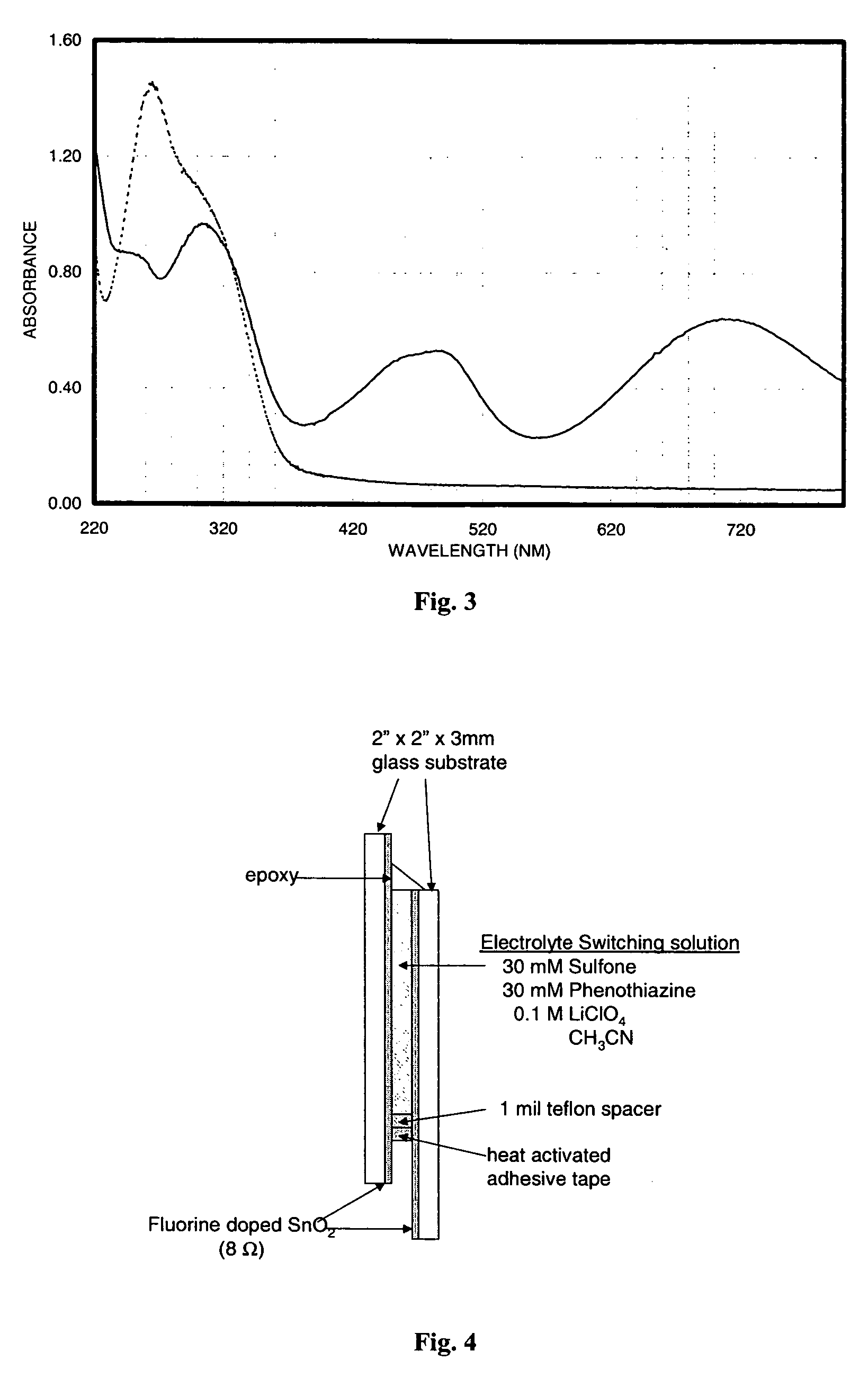Electrochromic materials and devices
a technology of electrochromic materials and devices, applied in the field of electrochromic materials, can solve the problems of inability to meet the requirements of inorganic electrochromic systems, and inability to achieve the effects of low operation voltage, easy variation, and ideal application properties
- Summary
- Abstract
- Description
- Claims
- Application Information
AI Technical Summary
Benefits of technology
Problems solved by technology
Method used
Image
Examples
example 1
Synthesis of Indanedione and Dicyanomethylidine Derivatives of Sulfones
[0062]Synthetic routes for the preparation of the intermediate 4H-thiopyran-4-one 1,1-dioxides with a variety of substituents at the 2- and 6-positions have been described in N. Rule, M. Detty, J. Kaeding, J. Sinicroopi, J. Org. Chem. 1995, 60, 1665, incorporated herein by reference. The thiopyran-4-one intermediates are easily converted into corresponding indanedione derivative by base catalyzed condensation with 1,3-indanedione in ethanol, as disclosed in U.S. Pat. No. 4,514,481 (page 3, line 60). Similarly, condensation of thiopyran-4-one 1,1-dioxides with malononitrile readily affords dicyanomethylidine derivatives, as disclosed in U.S. Pat. No. 4,514,481 (page 3, line 35).
example 2
Electrochromism of 2,6-di-(3-trifluorophenyl)-4H-1,1′-dioxo-4-(dicyanomethylidene)thiopyran (I-6) in acetonitrile
[0063]The electrochromic properties of 2,6-di-(3-trifluorophenyl)-4H-1,1-dioxo-4-(dicyanomethylidene)thiopyran, structurally represented by I-6 above, were determined in acetonitrile solution. The electrochemical reduction potential was measured by cyclic voltammetry to be −16 V vs SCE and gave colorless solutions, that is, solutions exhibiting no absorption in the visible region, when dissolved in a nonaqueous solvent such as acetonitrile. Controlled potential reduction at an applied potential of −0.5 V produced the intensely colored anion radical that exhibited spectral absorption across a broad region of the visible spectrum as indicated by the absorption spectrum of FIG. 1. The thiopyran radical anion had a very high optical absorption coefficient, measured to be 15,400 M−1cm−1, and thus produced a very high contrast change due to the electrochromic effect. The visibl...
example 3
Electrochromism of 2-phenyl 6-tolyl-4H-1,1-dioxo-4-(dicyanomethylidene)thiopyran (I-2) in acetonitrile
[0065]The electrochromic properties of 2-phenyl, 6-tolyl-4H-1,1-dioxo-4-(dicyanomethylidene)thiopyran, structurally represented above as I-2, were determined in acetonitrile solution. The electrochemical reduction potential of I-2 was measured by cyclic voltammetry to be −0.22 V vs SCE and gave pale yellow solutions when dissolved in a nonaqueous solvent such as acetonitrile. Controlled potential reduction at an applied potential of −0.5 V produced the intensely colored anion radical that exhibited spectral absorption across a broad region of the visible spectrum as indicated by the absorption spectrum of FIG. 2. The thiopyran radical anion had a very high optical absorption coefficient, measured to be 12,400 M−1cm−1, and thus produced a very high contrast change due to the electrochromic effect. The visibly colored anion radical was very stable, showing only minor changes in absorp...
PUM
| Property | Measurement | Unit |
|---|---|---|
| dielectric constant | aaaaa | aaaaa |
| dielectric constant | aaaaa | aaaaa |
| electrochemical reduction potential | aaaaa | aaaaa |
Abstract
Description
Claims
Application Information
 Login to View More
Login to View More - R&D
- Intellectual Property
- Life Sciences
- Materials
- Tech Scout
- Unparalleled Data Quality
- Higher Quality Content
- 60% Fewer Hallucinations
Browse by: Latest US Patents, China's latest patents, Technical Efficacy Thesaurus, Application Domain, Technology Topic, Popular Technical Reports.
© 2025 PatSnap. All rights reserved.Legal|Privacy policy|Modern Slavery Act Transparency Statement|Sitemap|About US| Contact US: help@patsnap.com



